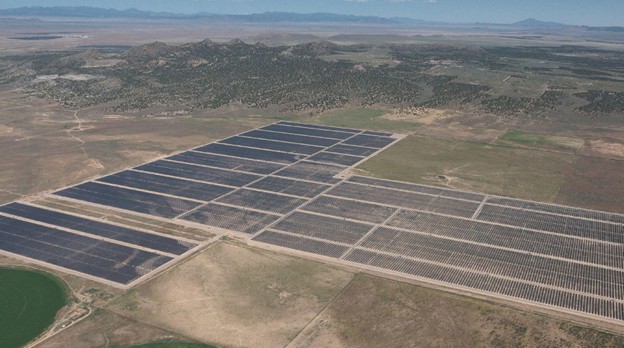Land bottlenecks slow down solar projects
Until recently, many solar developers relied on long-term options with minimal upfront cost, closing only when a project neared construction. That approach no longer works in many high-demand regions. Enter land finance as a practical alternative.

By Maria Klutey | Land availability has become a growing challenge in solar project development. A 2024 report by Paces, a renewable energy project planning software firm, found a 22% drop in available land across 12 U.S. states. This constraint now rivals other familiar project hurdles, such as interconnection delays and procurement risk. Developers also face rising costs, shrinking timelines and site control strategies that no longer align with today’s market.
Until recently, many solar developers relied on long-term options with minimal upfront cost, closing only when a project neared construction. That approach no longer works in many high-demand regions. Landowners increasingly demand early purchases or lease commitments. As a result, forward-thinking developers will need to treat land strategy as a key part of capital planning, which is leading to interest in land finance.
Land finance once carried a reputation as a tool for smaller, undercapitalized developers. That view no longer holds. Today, some of the largest independent power producers use land finance to move faster and manage capital more efficiently.
Rising costs, uncertain timelines
Solar developers often need to secure land years before reaching a project’s notice to proceed (NTP), a shift that adds financial risk early in the project lifecycle when uncertainty remains high.
That risk grows in high-demand and urban areas. As an example, San Diego land prices have reportedly reached as high as $10 million per acre. In contrast, West Texas land might cost $3,000 to $5,000 per acre until developers show interest. In the Electric Reliability Council of Texas (ERCOT) territory, that kind of demand can drive prices, sometimes approaching up to $20,000 per acre.
At the same time, landowners are less willing to offer multi-year options, often demanding immediate purchases or lease commitments. As a result, developers will need to move faster, pay more and carry land costs longer, often without knowing whether the project will proceed.
Limits of equity and traditional debt
Most developers use sponsor equity to purchase land. While this may seem straightforward, it creates capital inefficiencies. Land cannot be depreciated and does not qualify for the Investment Tax Credit (ITC). When developers include land inside the project entity, it lowers the project’s tax credit basis. At the same time, it ties up expensive equity in a non-revenue-generating asset.
Commercial lending rarely solves this gap. Banks typically lend based on appraised value, which may not reflect market prices, especially when landowners charge premiums. With conservative loan-to-value ratios, developers may receive only 20% to 40% of the required funding. The result? Developers may experience higher costs and reduced flexibility at a critical stage in development.
A practical alternative: land finance
Some developers now use land finance as a way to improve capital efficiency and reduce timeline risk. In this model, a third-party capital provider acquires the land and leases it back to the developer through a long-term agreement. This structure supports project financing, reduces equity strain and can improve ITC outcomes.
Unlike traditional project finance, land finance is a real estate transaction. It does not require full project underwriting, engineering reviews or lengthy negotiations. Many developers handle the process with in-house diligence and legal.
Because land finance providers focus solely on real estate, many deals close in 30-60 days. This speed helps developers maintain control of key parcels while preserving other forms of capital for later stages.
Let’s dive into one example.
Case Study: $21 million solar land deal closed in under 30 days
Recently, Accelerate successfully executed a $21 million sale-leaseback for land designated to host a 460 MW utility-scale solar project in Texas. The transaction occurred during the pre-NTP phase, enabling the developer to secure its land position well ahead of construction. The deal was structured and closed in under 30 days, highlighting this approach’s speedy execution. The project benefits from an existing long-term PPA with an investment-grade technology company, providing strong offtake security and long-term revenue stability.
Why developers should engage land capital early
Too often, developers wait until options expire or when landowners sell to competitors before exploring land finance. Some assume that construction lenders or internal funds will cover land costs, only to discover that those solutions don’t align with the project timeline or pricing realities.
Others confuse land finance with project finance, expecting delays or complex negotiations. In reality, land finance proves simpler. Many providers use standardized terms and can accommodate early-stage projects.
The best results come when developers consider land capital early, even if they don’t use it immediately. Understanding available options helps build more accurate financial models and reduces friction later in the project. Also, many developers benefit from separating land ownership from the main project entity. A standalone land-holding company adds minimal complexity but creates options for future financing, sale or restructuring.
What’s Ahead
A major developer recently shifted to a third-party land aggregator to improve transaction speed and flexibility. That partnership now supports a growing national pipeline of utility-scale projects after several successful closings.
As the renewable energy market evolves, pressure on land will continue to grow. Solar developers will continue to face more interconnection delays, rising construction costs and shifting policy as projects move closer to demand centers, integrate storage and push for faster timelines.
Land finance does not solve every challenge, but it addresses a critical one. With the right structure, solar developers can move faster, preserve capital and navigate complexity more effectively.
Maria Klutey is the Senior Vice President of Renewables at Accelerate. She brings more than 20 years of experience in renewable energy finance and has supported hundreds of land transactions across solar, wind and storage projects nationwide. For more on Accelerate, visit here.




